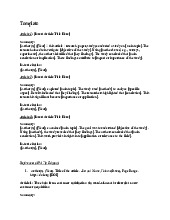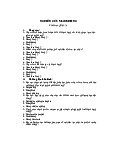






Preview text:
The Future Prospects and Potential of Edible Bird Nest Industry and Market
Edible Bird Nest Industry: Future Potential and Market
If you’re interested in buying or importing Edible Bird Nest from Indonesia, you can
contact us, Exco Natura Indonesia, through our contact us page or email us
at info@exconatura.com. We pride ourselves on providing high-quality Edible Bird
Nest that meets international standards. Don’t hesitate to reach out to us for more
information or to place an order. We look forward to serving you. Introduction
Bird nests have been enjoyed as a delicacy in many cultures for centuries, but none are more
prized than the nests made by the swiftlets. These tiny birds build their nests using their own
saliva, which hardens into a gel-like substance that is rich in protein and other nutrients. Known
as edible bird nests, these delicacies are highly valued for their unique texture and flavor, and are believed t
o offer a range o fhealth benefits.
Definition o fEdible Bird Nest Edible bird nest refers t
o the nests built by swiftlets that are harvested for consumption
purposes. Swiftlets are small birds that belong t o the Apodidae family.
The bird’s nest is composed mainly o fits solidified saliva, which is harvested before o r after the hatching o feggs o
r breeding young. The nests come in different shapes, sizes, colors, textures, and grades depending o
n various factors such as species o fswiftlet producing it, location where it was produced etc.
Brief History o fEdible Bird Nest Industry
The consumption o fedible bird nests dates back over 400 years ago t o ancient China during the
Ming Dynasty. It was believed that consuming edible bird nest could cure diseases and promote
longevity. Since then, it has become increasingly popular among people from different countries
around Southeast Asia such as Indonesia, Malaysia, Vietnam o r Thailand.
Today’s industry began developing in the 19th century when Chinese merchants started trading
them across international borders creating an export market for this luxury food item. Over time
processing techniques have improved allowing for mass production which has led t o new
opportunities for food products based o n this valuable material.
Importance of Edible Bird Nest Industry
The edible bird nest industry plays an important role in both cultural and economic aspects. It is
an important source of income for many communities, particularly those living in rural areas.
The industry also contributes t
o the economy through exports which generates foreign exchange
as well as supporting employment and business opportunities such as tourism. From a
nutritional perspective, edible bird nests are rich in protein, minerals and antioxidants. They have been found t
o provide numerous health benefits including boosting immunity,
improving digestion and promoting overall vitality. As such, there is growing interest in this
product from consumers around the world who are seeking natural and healthy food options.
The Current State o fEdible Bird Nest Industry and Market
Production and Consumption Statistics
Edible bird nests are produced primarily in Southeast Asia, with Indonesia, Thailand, and Malaysia being the to
p three producers. The production process involves harvesting nests from caves o
r specially designed houses, cleaning them thoroughly and then preparing them for sale. According t
o the Food and Agriculture Organization (FAO), the global production o fedible bird
nests was estimated at 24 metric tons in 2019. In terms o fconsumption, China represents the
largest market for edible bird nests.
Other significant markets include Hong Kong, Taiwan, Singapore, Macau and some other East
Asian countries. The Chinese government has been promoting the consumption o fedible bird nests due t
o its supposed health benefits. Major Players i n th e Market
The edible bird nest industry is largely dominated by small-scale farmers who produce these
highly prized products for export markets. However, there are some big players like Global Food
Solutions (GFS) and Swiftlet Eco Park who have invested in mass production facilities. One
notable company that has gained significant traction in this industry is Bird’s Nest Beverage Group Limited (BNBG).
BNBG is a Singapore-based company that produces a range o fbeverages made from high-quality
edible bird nests sourced from Southeast Asia. The company has been successful in expanding its market reach beyond Asia t
o other parts o fthe world including Europe and Australia. Trends and Challenges
One major trend in the edible bird nest industry is an increase in demand for organic o r
sustainably produced products due t
o concerns about environmental degradation caused by
unregulated harvesting practices. Another trend involves diversification into different product
lines. For example, several companies have started producing skincare products containing
compounds derived from edible bird nest extracts due t
o their purported anti-aging properties.
However, there are also many challenges facing this industry such as environmental concerns
surrounding the harvesting of bird nests, ethical issues surrounding labor practices and
harvesting from protected areas, and legal regulations governing trade in this industry. There is
also a need for improved quality control measures t
o ensure that consumers are getting genuine high-quality products.
The Future Prospects of Edible Bird Nest Industry and Market
Growing Demand for Health Supplements and Natural Products
Edible bird nests have been used for centuries in traditional Chinese medicine for their anti-
aging, immune-boosting, and health-promoting properties. With the rise of the health and
wellness industry, there has been a growing demand for natural products that can provide these benefits.
As a result, edible bird nests have gained popularity as a key ingredient in health supplements
such as capsules, teas, and powders. According t
o a report by Grand View Research Inc., the
global dietary supplements market size is expected t
o reach USD 230.73 billion by 2027.
This presents an immense opportunity for the edible bird nest industry t o expand its market
share by tapping into this growing demand. With its high nutritional value, low-calorie count,
and natural source o fprotein, calcium, iron and other minerals; edible bird nest is positioned t o
become a major contributor to this market. Advancements i
n Technology for Mass Production
One o fthe main challenges facing the edible bird nest industry is that it traditionally involves
handpicking nests from caves o
r man-made structures which limits mass production capabilities.
However with technological innovations in recent years such as automated farming systems ,
artificial nesting walls ,and scientific breeding techniques; it’s now possible t o cultivate swiftlet
birds and mass-produce edible bird nests at much higher volumes.
These advancements have opened u
p opportunities for new players t o enter the market without having t o rely o
n traditional harvesting methods o
r obtain access rights from cave owners which
are often very expensive. As more companies invest in sustainable cultivation practices coupled
with technological advancements in mass production capabilities; prices may drop further making it more accessible t o consumers at large.
Increasing Awareness about Nutritional Value of Edible Bird Nests
There has been increasing recognition o fthe nutritional value o fedible bird nests not just in
traditional Chinese medicine but also as a food source for humans. With its high protein content,
low-calorie count, and abundance o fmicronutrients such as calcium and iron; edible bird nests are positioned t
o become a staple in the diet o fhealth-conscious consumers. This has led t
o increasing demand from restaurants and chefs for incorporating edible bird nests
into their menus which has opened u
p new markets. As consumer awareness continues t o
increase, we can expect a shift towards more sustainable production practices t o cater t o this growing demand. Potential Opportunities i
n the Edible Bird Nest Industry Expanding int
o New Markets: A World of Possibilities
The edible bird nest industry has been predominantly concentrated in Asia, with China,
Indonesia, and Malaysia being the largest producers. However, there is a vast potential for
expansion into new markets globally.
The unique nutritional and health benefits of edible bird nests make them an attractive product
for health-conscious consumers worldwide. With increasing awareness about the beneficial
properties o fthese nests, there is a growing demand that can be capitalized on by expanding into new markets.
One such market is Europe, where an increasing number of consumers are seeking natural and
organic products. The high demand for organic products creates an opportunity for exporters t o tap into this market.
Another potential market is North America, where there has been a surge in popularity for
traditional Chinese medicine and natural supplements. With targeted marketing strategies and
partnerships with local distributors, edible bird nest producers can carve out their niche in these emerging markets.
Diversifying Product Offerings: Innovative Products t o Meet Customer Demands
Diversifying product offerings can help edible bird nest producers expand their customer base and cater t
o varying preferences. For instance, producing different grades o fnests based o n size or color can appeal t
o different consumer segments. Additionally, developing new products such as ready-to-eat snacks o
r beverages containing bird nest extract may attract more customers looking for convenient ways t o consume it.
There are also opportunities t o develop premium o
r specialized products that cater t o specific
customer demands such as high-quality cosmetic creams o
r beauty supplements. Emphasizing
the specific health benefits associated with these products through targeted marketing
campaigns will enable producers t
o create a loyal customer base. Investing i
n Sustainable Farming Practices: A Pathway T o Longevity And Growth
The sustainability o fthe industry’s production practices has been a significant concern due t o
destructive harvesting practices and the impact o
n bird populations. To ensure long-term
growth, businesses in the edible bird nest industry must adopt sustainable farming practices. One such practice is t
o promote organic and environmentally friendly farming techniques that reduce the impact o
n the bird population and its habitat.
This approach can not only help maintain healthy bird populations but also enhance product
quality. Moreover, investing in modern technology and research t o improve farming efficiency
can help producers save costs and increase yields.
Expanding into new markets, diversifying product offerings, and investing in sustainable farming
practices are key opportunities for edible bird nest industry players seeking growth. By focusing
on these opportunities while addressing potential challenges such as ethical harvesting
practices, businesses can pave a path towards sustainability and profitability in this emerging industry.
Challenges Facing the Edible Bird Nest Industry
The edible bird nest industry is facing numerous challenges as it continues t o grow. In this
section, we will explore the to
p three challenges that are affecting the industry and what can be done t o address them. Environmental Concerns
One o fthe biggest challenges facing the edible bird nest industry is environmental concerns.
Birds build their nests on high cliffs and caves, which are becoming increasingly threatened by
human activities such as mining and urbanization. This has resulted in a decline in bird
populations and nesting sites.
The destruction o fthese sites has led t
o a decrease in natural production o fedible bird nests,
which in turn has led to an increase in illegal harvesting. To address this challenge, it is
important for governments and NGOs t
o work together to protect the natural habitats o fthese birds.
This can be achieved through establishing protected areas o
r sanctuaries where birds can safely
nest without fear o fhuman interference. Education campaigns and awareness programs can also
help raise awareness among consumers about environmental issues related t o edible bird nests and encourage them t
o support sustainable farming practices.
Ethical Issues Surrounding Harvesting Practices
Another major challenge facing the edible bird nest industry is ethical issues surrounding
harvesting practices. Traditional harvesting methods involve climbing steep cliffs o r using long bamboo poles t
o extract nests from caves – putting harvesters at significant risk o finjury o r death from falling o r other accidents.
To address this issue, there needs to be more stringent regulations on harvesting practices that
ensure safety for workers as well as ethical treatment of birds during nesting season. It may also
be necessary for companies involved in the production o fedible bird nests t o invest in
technologies that allow for safer and more efficient extraction methods. Legal Regulations
The final challenge facing the edible bird nest industry is legal regulations. As demand for edible
bird nests continues to grow, there has been an increase in illegal harvesting and trade, which
threatens the sustainability of the industry.
In some cases, unscrupulous sellers have been known t o sell fake o r poor-quality nests that do
not meet nutritional standards. To address this issue, governments need t o establish clear legal
frameworks that regulate the production and trade of edible bird nests.
These regulations should include provisions for sustainable farming practices, safety standards
for harvesters and ethical treatment o fbirds during nesting season. Companies involved in the
industry should also be required t o adhere t
o strict quality control standards that ensure only
genuine and high-quality nests are sold t o consumers.
Conclusion: Protecting the Future of Edible Bird Nest Industry
Despite these challenges facing the edible bird nest industry, there is still a bright future ahead
for this natural health supplement. By addressing environmental concerns through sustainable
farming practices and protecting natural habitats, implementing safer harvesting methods that
are more ethical towards both workers and birds during nesting season as well as introducing more stringent regulations o
n production and trade of edible bird nests can help ensure a
sustainable future for this unique industry.
The Bright Future Ahead for the Edible Bird Nest Industry
Shifting Consumer Preferences and Growing Demand for Health Supplements
The edible bird nest industry has a bright future as consumers continue t o prioritize health and
wellness. The demand for natural health supplements has been growing steadily over the years,
and edible bird nests are increasingly becoming a preferred choice among consumers due to
their high nutritional value. With its rich protein content, antioxidants, and other vital nutrients,
the edible bird nest is well positioned t
o take advantage of these trends.
Moreover, the increasing awareness about the health benefits o fconsuming bird’s nests is
driving an uptick in demand from global markets. As such, producers can shift their focus from traditional markets t
o new markets that offer untapped potential. Advancements i
n Technology for Mass Production
Advancements in technology have had a profound impact on many industries including
agriculture. In the case of edible bird nests, technological innovations are making it easier t o
produce higher yields without compromising quality o
r sustainability. This means that
producers can now meet growing demand while ensuring environmental sustainability.
Furthermore, new technologies are emerging that allow producers t o better monitor bird
populations and minimize risks associated with harvesting practices. This enhances traceability
throughout the supply chain ensuring quality control and ethical practices. Investing i
n Sustainable Farming Practices
Sustainability remains at the forefront o fconsumer preferences across various industries. As
such, investing in sustainable farming practices will be key for players in the edible bird nest industry moving forward.
While environmental concerns surrounding harvesting practices have long plagued this industry,
there is hope for a more sustainable future. Producers can invest in alternative methods such as
breeding programs which could help reduce pressure o
n wild populations while increasing yields over time.
Additionally, adopting organic farming practices would also appeal t o health-conscious
consumers who prioritize environmentally-friendly products. The bright future ahead for the
edible bird nest industry is promising.
With shifting consumer preferences, growing demand for health supplements, advancements in
technology for mass production and investing in sustainable farming practices. The industry can
meet this increased demand while ensuring sustainability. References:
1. Edible Birds Nest Market Size | Trends | Growth | Scope to 2031 | LinkedIn
2. Edible Bird’s Nest Market Global Analysis 2023-2030 – MarketWatch
3. Edible Bird’s Nest Market 2022-2028 Top Companies report (globenewswire.com)
4. Edible Bird’s Nest MarketRising Trends, Growing Demand and Regional Analysis and
Forecast 2028 (digitaljournal.com)
5. Edible Bird’s Nests – a
n overview | ScienceDirect Topics



